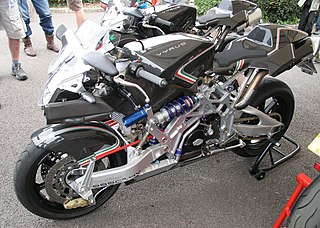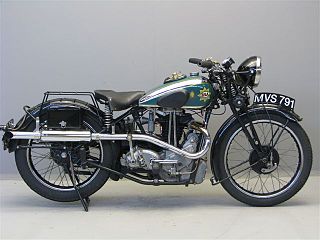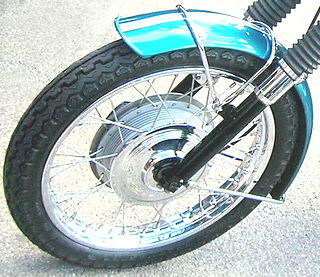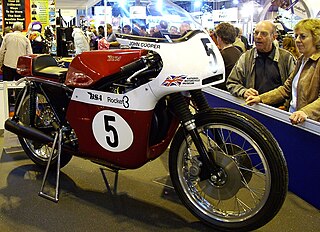
Stanley Michael Bailey Hailwood, was an English professional motorcycle racer and racing driver. He is regarded by many as one of the greatest racers of all time. He competed in the Grand Prix motorcycle world championships from 1958 to 1967 and in Formula One between 1963 and 1974. Hailwood was known as "Mike The Bike" because of his natural riding ability on motorcycles with a range of engine capacities.

The Bol d’Or is a 24-hour endurance race for motorcycles, held annually in France. The race is part of the FIM Endurance World Championship. The riding of each bike is now shared by a team of three riders.

Laverda was an Italian manufacturer of high performance motorcycles. The motorcycles in their day gained a reputation for being robust and innovative.

Hub-center steering (HCS) is one of several different types of front-end suspension/steering mechanisms used in motorcycles and cargo bicycles. Hub-center steering is characterized by the steering pivot points being inside the hub of the wheel, rather than above the wheel in the headstock as in the traditional layout. Most hub-center arrangements employ a swingarm that extends from the bottom of the engine/frame to the center of the front wheel.

Phillip William Read, was an English professional motorcycle racer. He competed in Grand Prix motorcycle racing from 1961 to 1976. Read is notable for being the first competitor to win world championships in the 125 cc, 250 cc and 500 cc classes. Although he was often overshadowed by his contemporary, Mike Hailwood, he won seven FIM Grand Prix road racing world championships.

The BSA Gold Star is a motorcycle made by BSA from 1938 to 1963. They were 350 cc and 500 cc single-cylinder four-stroke production motorcycles known for being among the fastest bikes of the 1950s. Being hand built and with many optional performance modifications available, each motorcycle came from the factory with documented dynamometer test results, allowing the new owner to see the horsepower (bhp) produced.

The Endurance World Championship is the premier worldwide endurance championship in motorcycle road racing. The championship season consists of a series of endurance races held on permanent racing facilities. The results of each race are combined to determine three World Championships – riders, teams and manufacturers.
The Thruxton 500 was a motorcycle endurance race for production based road machines, covering 500 miles and ridden by a team of two riders per machine. The first event was a 9-hour race which took place in 1955, organized by the Southampton and District Motorcycle Club (SDMCC) at the Thruxton Circuit near Andover in Hampshire. Two more 9-hour races followed in 1956 and 1957.

The Velocette Thruxton was a sporting motorcycle produced by Velocette between 1965 and 1971. Revealed at the 1964 Earls Court Show, it was the final development of Velocette's antiquated pushrod single, the Venom.

The Velocette Venom was a 499 cc single-cylinder four-stroke British motorcycle made by Velocette at Hall Green in Birmingham. A total of 5,721 machines were produced between 1955 and 1970.

The featherbed frame was a motorcycle frame invented by the McCandless brothers and offered to the British Norton motorcycle company to improve the performance of their racing motorcycles in 1950. It was considered revolutionary at the time, and the best handling frame that a racer could have. Later adopted for Norton production motorcycles, it was also widely used by builders of custom hybrids such as the Triton, becoming legendary and remaining influential to this day.
Percy Tait was an English professional motorcycle road racer and senior road tester for Triumph motorcycles, where he was estimated to have covered over a million miles of road testing. He later became a farmer specialising in award-winning rare breeds of sheep.
The BSA B50 was a single-cylinder 499 cc (30.5 cu in) ohv motorcycle, produced by BSA at their factory in Small Heath, Birmingham. The last of the big capacity unit-construction singles from the Birmingham Small Arms company, it had an alloy engine with a bore of 84 mm (3.3 in) and a stroke of 90 mm (3.5 in). As well as the road version, special models were produced for off-road competition use.

The Empire Star was a standard motorcycle made by BSA at their factory in Small Heath, Birmingham. Named to commemorate the Silver Jubilee of King George V of the United Kingdom and advertised as The Masterpiece of the Industry, the Empire Star range was produced between 1936 and 1939, when it was developed into the BSA Gold Star and World War II stopped production.

Slippery Sam is a British production class racing motorcycle from the early 1970s that used a carefully prepared version of the 750 cc Triumph Trident ohv (pushrod) three-cylinder engine. The "Slippery Sam" name was acquired during the 1970 Bol d'Or, a 24-hour race for production-based machines held in France, when engine difficulties and escaping oil covered the bike of Triumph employee Percy Tait and co-rider Steve Jolly who managed to finish in fifth place to winners Paul Smart and Tom Dickie on another works Trident.

The Dunlop K81 TT100 is a motorcycle tyre thought to be an "obligatory" performance upgrade and a tyre of choice with sporting street motorcyclists during the late 1960s and 1970s due to their shape and relatively sticky compound.

BSA motorcycles were made by the Birmingham Small Arms Company Limited (BSA), which was a major British industrial combine, a group of businesses manufacturing military and sporting firearms; bicycles; motorcycles; cars; buses and bodies; steel; iron castings; hand, power, and machine tools; coal cleaning and handling plants; sintered metals; and hard chrome process.

The 1971 Anglo-American Match Races was the inaugural running of the Anglo-American Match Races, an annual series of motorcycle races between the United Kingdom and America which were held from 1971 to 1988 and again in 1991. The match was held 9-12 April 1971 with rounds at Brands Hatch, Mallory Park and Oulton Park. The event was heavily sponsored by BSA/Triumph. They also supplied the 750 cc racing triples that the riders competed on. The motorcycles were to AMA/F750 specification. Most of the competitors were work BSA/Triumph works riders.
David William Potter was an English motorcycle racer who won the British Superbike Championship twice. Potter crashed during a race at Oulton Park on 31 August 1981 and suffered head injuries from which he died in hospital 17 days later.

The BSA/Triumph racing triples were three cylinder 750 cc racing motorcycles manufactured by BSA/Triumph and raced with factory support from 1969-1974. There were road racing, production racing, endurance racing and flat track variants. The machines were based on the road-going BSA Rocket 3/Triumph Trident.

















